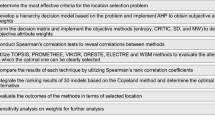Abstract
A method is presented for selecting a preferred ship from a group of candidates as a reference ship for a new design. The method is based on a recently developed approach for multiple-criteria decision analysis under uncertainty, the evidential reasoning approach. Using this method, both quantitative and qualitative attributes of a complicated nature can be considered in the selection process. The method consists of three phases: identifying suitable candidate ships, evaluating them in terms of both conventional techno-economical and qualitative attributes, and aggregating all the attributes using the evidential reasoning approach. This three-phase procedure is illustrated by means of an oil tanker selection example. The results of this study show that the evidential reasoning approach can support multiple-criteria ship selection processes when both qualitative and quantitative information with or without uncertainties have to be taken into account. The outcomes generated by the method include the ranking of the candidate ships and indications of their strengths and weaknesses in the format of performance distributions over different assessment grades. Such information is vital in helping decision makers to make an informed selection and be aware of any risk implication associated with the selection.
Similar content being viewed by others
References
Tupper E (1996) Introduction to naval architecture, 3rd edn. Butterworth-Heinemann, Oxford
Ji Z (1994) General design of oil tankers. The Publishing Company of Dalian University of Technology, Dalian, China
Kakamoukas CV (1979) A model for the realistic evaluation of ship investment and operation. In: Kuo C, MacCallum KJ, Williams TJ (eds) Proceedings of the conference on computer applications in the automation of shipyard operation and ship design III. North-Holland, Amsterdam, pp37–44
Yang Y, Qin S, Hu Y (1981) Calculations of principal dimensions of dry cargo ships by two optimization algorithms. Shipbuilding of China 1:1–8
Sönmez M, Yang J, Holt GD (2001) Addressing the contractor selection problem using an evidential reasoning approach. Eng Construct Archit Manag 8(3):198–210
Yang Y, Zhang R (1982) The determination of principal dimensions and economic evaluation of multi-purpose dry cargo ships. J Shanghai Jiao Tong Univ 3:87–101
Li S (1990) Feasibility analysis of merchant ships. The Publishing Company of Dalian University of Technology, Dalian, China
Lin J (1981) Elements of ship design. National Defence Industry Press, Beijing
Xie X, Teng Y, Gao F, et al (2001) Ship type evaluation for transportation of importing crude oil into China. Navigation of China 48:77–83
Zhang R (2001) Economics of ship engineering. Printing House of Shanghai Jiao Tong University, Shanghai
Benford H (1991) A naval architect’s guide to practical economics. Department of Naval Architecture and Marine Engineering, University of Michigan, No. 319, Ann Arbor
Dykstra DL (2005) Commercial management in shipping. The Nautical Institute, London
Munro-Smith R (1975) Elements of ship design. Marine Management (Holdings), London
Shafer GA (1976) Mathematical theory of evidence. Princeton University Press, Princeton, NJ
Yang J, Liu J, Wang J, et al (2006) A belief rule-base inference methodology using the evidential reasoning approach—RIMER. IEEE Trans Systems Man Cybernetics—Part A 36(2):266–285
Yang J, Xu D (2002) On the evidential reasoning algorithm for multiple attribute decision analysis under uncertainty. IEEE Trans Systems Man Cybernetics—Part A 32(3): 289–304
Yang J (2001) Rule-and utility-based evidential reasoning approach for multi-attribute decision analysis under uncertainties. Eur J Op Res 131(1):31–61
Yang J, Singh MG (1994) An evidential reasoning approach for multiple attribute decision making with uncertainty. IEEE Trans Systems Man Cybernetics 24(1):1–18
Yang J, Xu D (2005) The IDS multi-criteria assessor software. Intelligent Decision System, Cheshire, UK
Keeney RL, Raiffa H (1976) Decisions with multiple objectives: preferences and value trade-offs. Wiley, New York
French S (1986) Decision theory: an introduction to the mathematics of rationality. Ellis Horwood, New York
Author information
Authors and Affiliations
Corresponding author
About this article
Cite this article
Xie, X., Xu, DL., Yang, JB. et al. Ship selection using a multiple-criteria synthesis approach. J Mar Sci Technol 13, 50–62 (2008). https://doi.org/10.1007/s00773-007-0259-4
Received:
Accepted:
Published:
Issue Date:
DOI: https://doi.org/10.1007/s00773-007-0259-4




